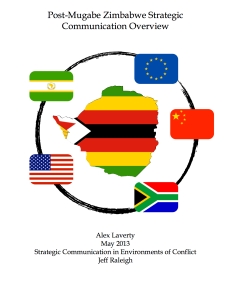 In my most recent post over at the Democracy in Africa blog, I argued that using mobile phones for political opinion polls would be an effective way of identifying voter fraud as well as providing feedback for political parties. My argument sought to use the ubiquity of mobile phones in Zimbabwe to overcome the lack of landlines needed to ‘traditional’ polling and the challenges of conducting in-person surveys in rural communities. Even though we know that not everyone owns or has access to a mobile phone, with penetration almost 100%, this medium made the most sense in order to capture the most complete sample of the prospective Zimbabwean voter. Still, understanding how those who own mobile phones are different from those that don’t will be important for the generalizability of the survey. Additionally, those that respond to an SMS based poll versus citizens that do not will likely need to be explored for the purposes of generalizing the results of the survey. With these questions in mind, I’ve expanded on the the model I described at DIA to a version that would incorporate more of these variables. Below are some additional factors to include in the survey:
In my most recent post over at the Democracy in Africa blog, I argued that using mobile phones for political opinion polls would be an effective way of identifying voter fraud as well as providing feedback for political parties. My argument sought to use the ubiquity of mobile phones in Zimbabwe to overcome the lack of landlines needed to ‘traditional’ polling and the challenges of conducting in-person surveys in rural communities. Even though we know that not everyone owns or has access to a mobile phone, with penetration almost 100%, this medium made the most sense in order to capture the most complete sample of the prospective Zimbabwean voter. Still, understanding how those who own mobile phones are different from those that don’t will be important for the generalizability of the survey. Additionally, those that respond to an SMS based poll versus citizens that do not will likely need to be explored for the purposes of generalizing the results of the survey. With these questions in mind, I’ve expanded on the the model I described at DIA to a version that would incorporate more of these variables. Below are some additional factors to include in the survey:
Sample frame:
The target of the survey would be the 13 million mobile phone subscribers in Zimbabwe. With a population just around 13 million, it can be reasonable to assume that the majority of citizens have an active mobile phone. To draw a random sample of this group in order to conduct the survey, two methods could be undertaken:
Random digit dialing: After inputing the correct prefixes for cell numbers in Zimbabwe (71, 73, and 77) a machine can dial random phone numbers. This makes it easy to replace any disconnected or unused numbers with the next random phone number.
Sample frame from the Telecoms: After partnering with the three major providers in Zimbabwe (Econet, Telecel, and Net*One), a list can be compiled of the numbers that have been active in the past 30 days from which to randomly sample. However, with many users changing SIM cards as they travel, or to take advantage of better rates, the list of active lines may include some that belong to the same person.
Weighting the Sample:
To compensate for a survey that does not perfectly represent the entire country of Zimbabwe, weights can be added to response groups in order to match the proportions known in the population. As an example, oversampling Sindebele speakers (who are only around 15%) or urban residents (5 million of the 13 million in the country) could be reproportioned to compenstate. This would not help if the sample itself is unrepresentative, but for the purposes of this project, the sample of mobile users is assumed to be the best representative sample that can be achieved.
Pre-testing
To make sure that the survey was successful it would need at least one round of testing (a pilot program) to flesh out the right wording of the questions and the right incentive for response. Usually this is done by running the survey twice with only one difference in the implementation. One group could be asked about their ethnicity or language, and the other would not, in order to see if the overall response rate dropped because people were put off by the question. Other pilots could test the level of incentive needed to ensure a high response rate. Does 25c of airtime make it worth someone’s time?
Finally, what information people are told about the survey before they participate will be crucial to gauge. While Americans are used to pollsters calling for their opinion and assume that their anonymity will be protected, this can not be said around the world. Does  a public campaign need to be undertaken? Can a SMS with a url link to a website do the trick? Understanding what information is needed by those surveyed to have enough trust in order to respond will be one of the most crucial steps taken.
a public campaign need to be undertaken? Can a SMS with a url link to a website do the trick? Understanding what information is needed by those surveyed to have enough trust in order to respond will be one of the most crucial steps taken.
Conclusion:
With these factors in mind, the formation of a mobile-based public opinion survey in Zimbabwe could be begun. Generalizability will be a crucial component for this survey as it’s likely to be one of the most critiqued factors. Those that respond to the survey could be less fearful that their answers might offend the security regime, and thus more likely to be ZANU-PF supporters. Conversely, those that do not own mobile phones are more likely to be poor and rural citizens, and are a group that ZANU-PF has consistently targeted for electoral support. These plus other factors need to be overcome by the structure of the final form of the survey in order to produce a non-response rate of less than 30%. Any more and there’s no chance of generalizing about the voting habits of the Zimbabwean populace. Despite fine tuning the sample frame, correctly weighting the demographics, or identifying the right incentive, Zimbabweans may still be resistant to mobile polling. If the risks perceived by a voter in revealing their political preference cannot be assuaged by those conducting the survey, then high measurement error will likely result.
Despite the challenges and difficulties in achieving a proper survey, there is a clear social benefit provided to the Zimbabwean people. Polling allows a population to give instant feedback to political parties and candidates during elections. While the United States has become obsessed with polling to the point of superfluousness, citizens are able to indicate their preferences at various times, rather than just through a one-off election. Additionally, election monitors can use the trends of polling to provide a more accurate assessment of whether elections have been rigged or manipulated. If monitors know that Province A had been trending support of 60% for candidate A but in the election candidate B receives 70% of the vote, a red flag can be triggered and thus alert monitors to further investigate the results. Without knowing pre-election opinions, no one can be certain if the populace truly voted the way they did.
Democracy is at a standstill in Africa despite recent headlines. Technology will not be a democratizing agent on its own. However, if used in certain circumstances to improve accountability, transparency, or connectivity, we should embrace the chance help consolidate existing republics as well as bringing forth more democratic regimes in Africa.
This article is an addendum to an article posted on Democracy in Africa






